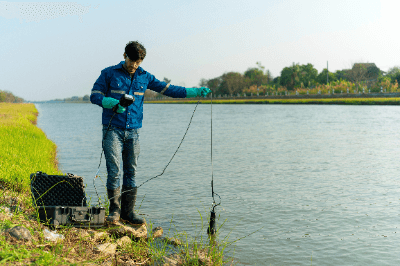What Is a Water Tester?

Water testers are water quality meters capable of evaluating multiple components simultaneously in a single measurement. The specific components that can be measured may vary depending on the instrument. These testers are designed for field use, built to withstand impact, and are easy to operate with one hand. While capabilities vary between devices, most water testers can measure fundamental water quality parameters such as pH, electrical conductivity, dissolved oxygen, and temperature. Multiple sensors are combined and connected to the main unit via a cord, and the measurement results are displayed on the main unit.
Uses of Water Testers
Water testers are employed to measure the constituents of river water, groundwater, and industrial wastewater. They are primarily intended for field use and practical applications. The sensor part and the main unit are connected via a connector, and the sensor is immersed directly into the water body or tank to be measured. Longer cables are available, allowing measurements while moving along the flow of a river or in deep lakes and marshes. Depending on the device, it can also be inserted directly into a pipe for measurements during a borehole survey, offering versatile applications based on the instrument’s capabilities.
Principle of Water Testers
Water testers employ different sensors and principles to measure various parameters. The key water quality measurement parameters that can be measured with water testers are described below.
1. pH
pH refers to the concentration of hydrogen ions and is a fundamental parameter in water quality measurement because it indicates the characteristics of the solution. pH sensors must be calibrated with a standard solution before use. Most water testers use a glass electrode method to measure pH.
2. Electrical Conductivity (EC)
Electrical conductivity (EC) expresses the ease with which electricity flows in a solution. The higher the concentration of substances dissolved in a solution, the greater its electrical conductivity. For instance, seawater, which contains dissolved salts, has a higher electrical conductivity. Since there is a constant relationship between conductivity and salinity, it is possible to determine salinity from conductivity and temperature.
3. Dissolved Oxygen (DO)
Living organisms in water rely on oxygen dissolved in the water for survival. Since the amount of dissolved oxygen varies depending on environmental factors such as temperature, it is used as a measurement parameter. Various measurement methods exist for dissolved oxygen, and sensors require regular maintenance.